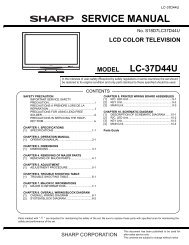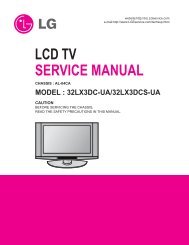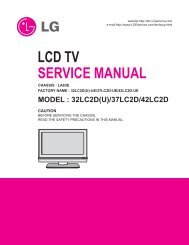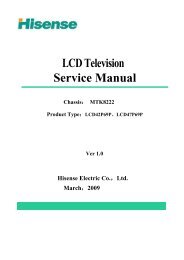Create successful ePaper yourself
Turn your PDF publications into a flip-book with our unique Google optimized e-Paper software.
1 Safety Precautions<br />
1.1. General Guidelines<br />
1. When servicing, observe the original lead dress. If a short circuit is found, replace all parts which have been overheated or<br />
damaged by the short circuit.<br />
2. After servicing, see to it that all the protective devices such as insulation barriers, insulation papers shields are properly<br />
installed.<br />
3. After servicing, make the following leakage current checks to prevent the customer from being exposed to shock hazards.<br />
1.1.1. Leakage Current Cold Check<br />
1. Unplug the AC cord and connect a jumper between the two prongs on the plug.<br />
2. Measure the resistance value, with an ohmmeter, between the jumpered AC plug and each exposed metallic cabinet part on<br />
the equipment such as screwheads, connectors, control shafts, etc. When the exposed metallic part has a return path to the<br />
chassis, the reading should be between 1M� and 5.2M�.<br />
When the exposed metal does not have a return path to the chassis, the reading must be .<br />
Figure 1<br />
1.1.2. Leakage Current Hot Check (See Figure 1.)<br />
1. Plug the AC cord directly into the AC outlet. Do not use an isolation transformer for this check.<br />
2. Connect a 1.5k�, 10 watts resistor, in parallel with a 0.15µF capacitors, between each exposed metallic part on the set and a<br />
good earth ground such as a water pipe, as shown in Figure 1.<br />
3. Use an AC voltmeter, with 1000 ohms/volt or more sensitivity, to measure the potential across the resistor.<br />
4. Check each exposed metallic part, and measure the voltage at each point.<br />
5. Reverse the AC plug in the AC outlet and repeat each of the above measurements.<br />
6. The potential at any point should not exceed 0.75 volts RMS. A leakage current tester (Simpson Model 229 or equivalent) may<br />
be used to make the hot checks, leakage current must not exceed 1/2 milliamp. In case a measurement is outside of the limits<br />
specified, there is a possibility of a shock hazard, and the equipment should be repaired and rechecked before it is returned to<br />
the customer.<br />
3<br />
<strong>TY</strong>-<strong>FB9TU</strong>















